Evidence-Based Practice: Honey for Diabetic Wound Healing
VerifiedAdded on 2023/06/03
|23
|2202
|374
Report
AI Summary
This report critically appraises the use of honey in accelerating wound healing for diabetic patients, employing the PICO(T) framework. It synthesizes findings from five research articles, including observational studies, randomized controlled trials, and systematic reviews, to evaluate honey's efficacy compared to standard wound care. The analysis highlights key themes such as honey's effectiveness in reducing wound healing time, bacterial clearance, and the potential of Manuka honey-impregnated dressings. The report also incorporates patient and clinician perspectives, discussing the benefits and implications of implementing honey-assisted wound healing in clinical practice, and provides recommendations for its integration into healthcare settings, including staff training and public awareness initiatives. The report is a contribution to Desklib, a platform for AI-based study tools.
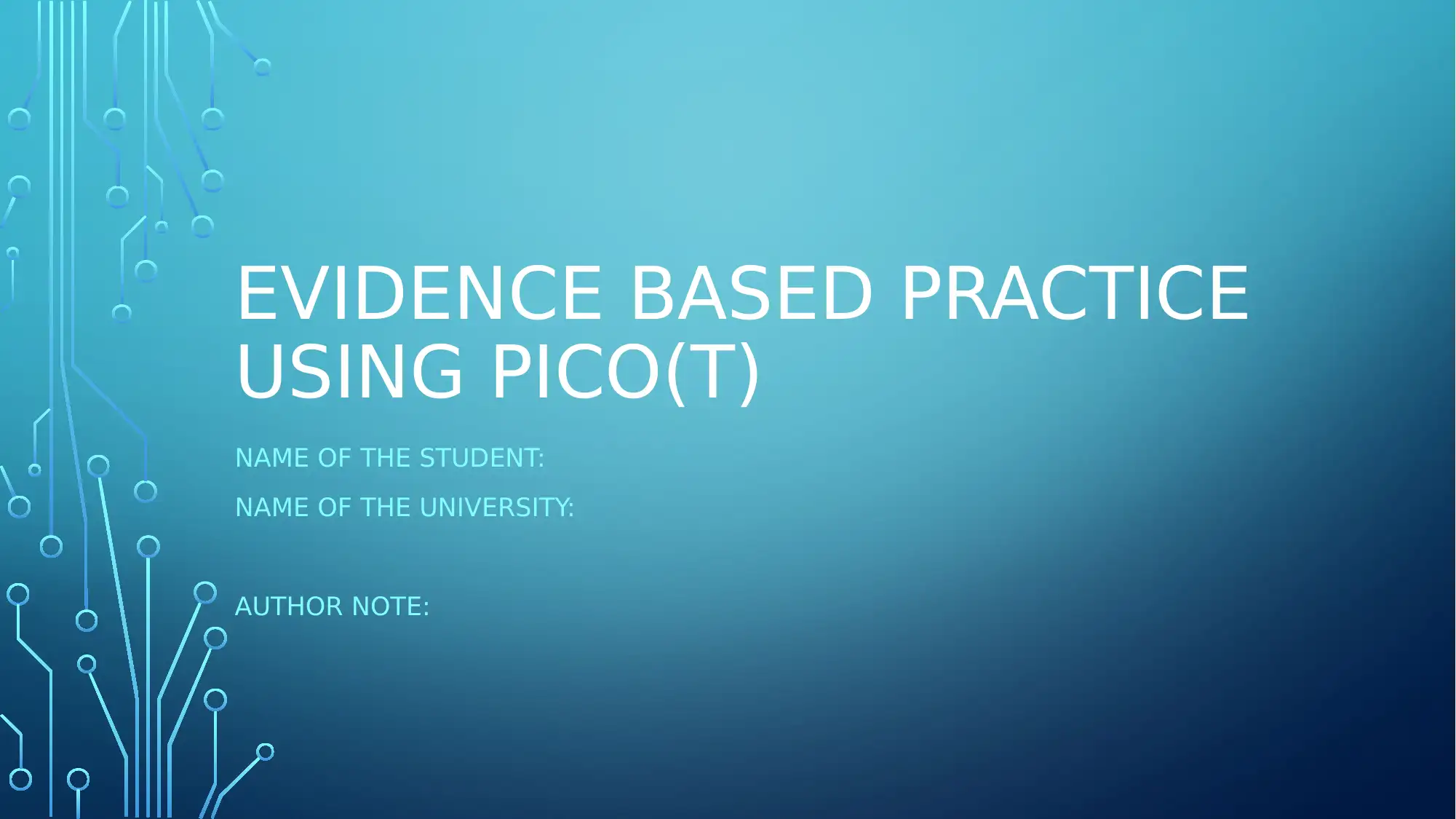
EVIDENCE BASED PRACTICE
USING PICO(T)
NAME OF THE STUDENT:
NAME OF THE UNIVERSITY:
AUTHOR NOTE:
USING PICO(T)
NAME OF THE STUDENT:
NAME OF THE UNIVERSITY:
AUTHOR NOTE:
Secure Best Marks with AI Grader
Need help grading? Try our AI Grader for instant feedback on your assignments.
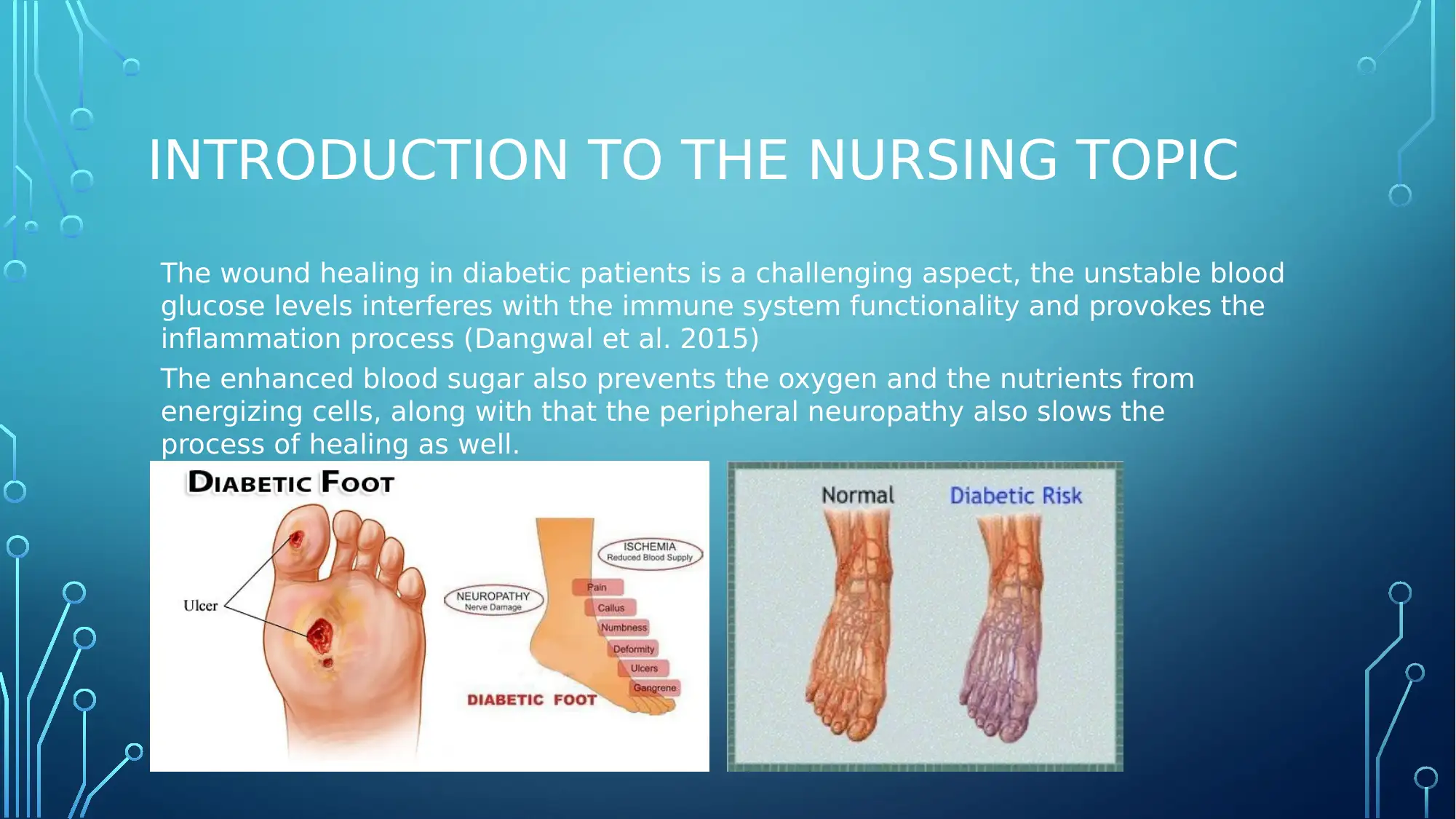
INTRODUCTION TO THE NURSING TOPIC
The wound healing in diabetic patients is a challenging aspect, the unstable blood
glucose levels interferes with the immune system functionality and provokes the
inflammation process (Dangwal et al. 2015)
The enhanced blood sugar also prevents the oxygen and the nutrients from
energizing cells, along with that the peripheral neuropathy also slows the
process of healing as well.
The wound healing in diabetic patients is a challenging aspect, the unstable blood
glucose levels interferes with the immune system functionality and provokes the
inflammation process (Dangwal et al. 2015)
The enhanced blood sugar also prevents the oxygen and the nutrients from
energizing cells, along with that the peripheral neuropathy also slows the
process of healing as well.
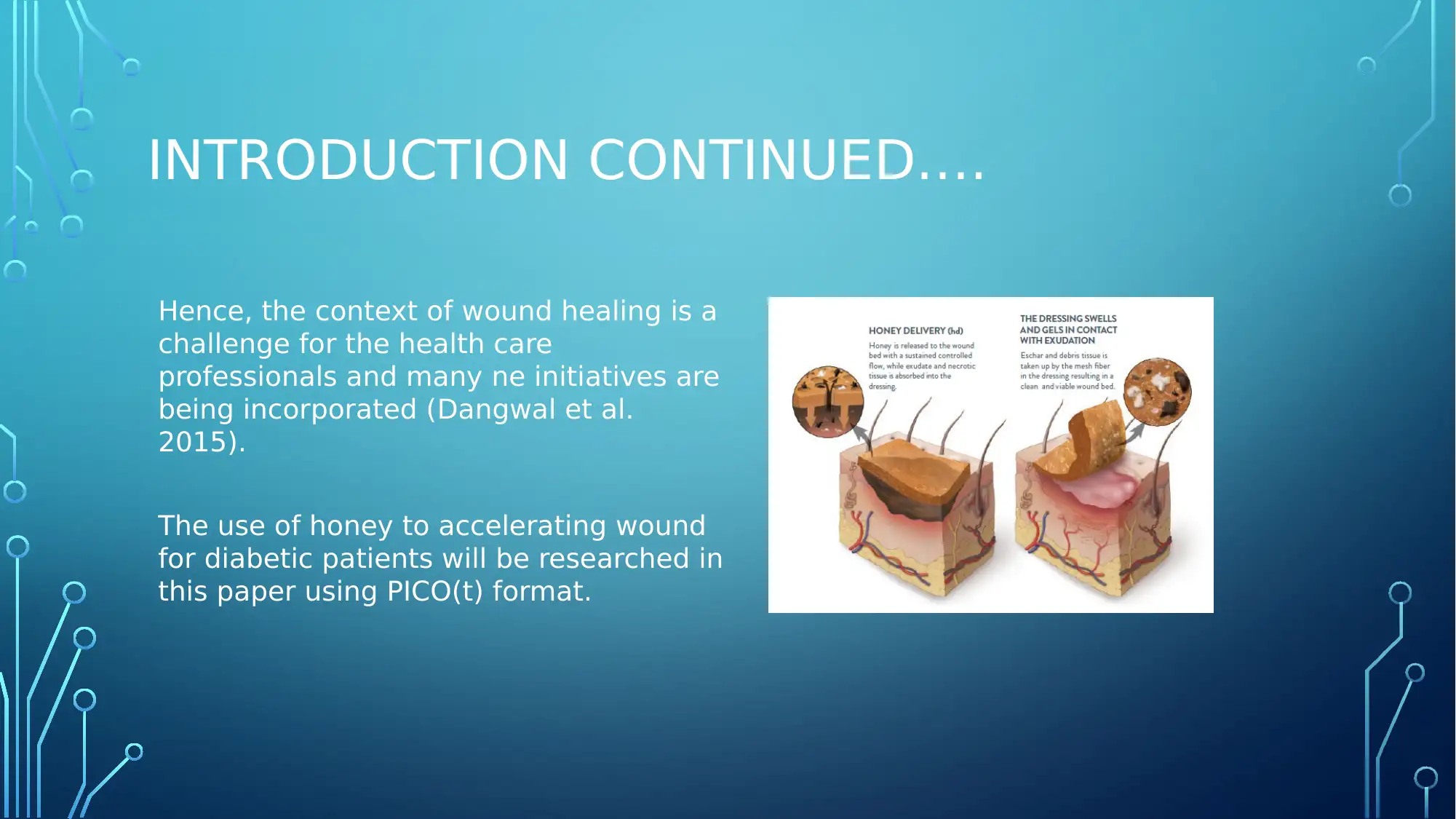
INTRODUCTION CONTINUED….
Hence, the context of wound healing is a
challenge for the health care
professionals and many ne initiatives are
being incorporated (Dangwal et al.
2015).
The use of honey to accelerating wound
for diabetic patients will be researched in
this paper using PICO(t) format.
Hence, the context of wound healing is a
challenge for the health care
professionals and many ne initiatives are
being incorporated (Dangwal et al.
2015).
The use of honey to accelerating wound
for diabetic patients will be researched in
this paper using PICO(t) format.
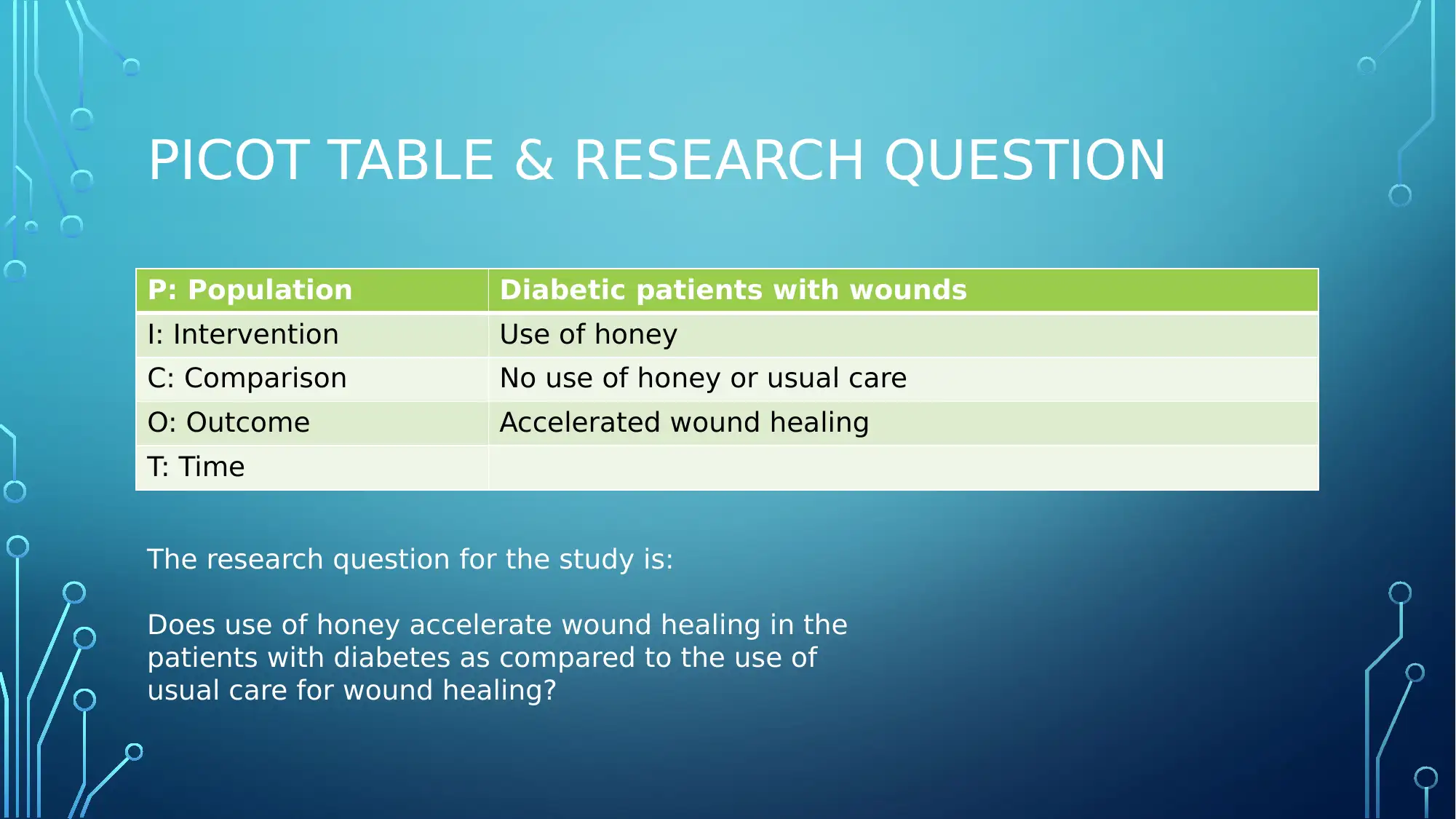
PICOT TABLE & RESEARCH QUESTION
P: Population Diabetic patients with wounds
I: Intervention Use of honey
C: Comparison No use of honey or usual care
O: Outcome Accelerated wound healing
T: Time
The research question for the study is:
Does use of honey accelerate wound healing in the
patients with diabetes as compared to the use of
usual care for wound healing?
P: Population Diabetic patients with wounds
I: Intervention Use of honey
C: Comparison No use of honey or usual care
O: Outcome Accelerated wound healing
T: Time
The research question for the study is:
Does use of honey accelerate wound healing in the
patients with diabetes as compared to the use of
usual care for wound healing?
Secure Best Marks with AI Grader
Need help grading? Try our AI Grader for instant feedback on your assignments.
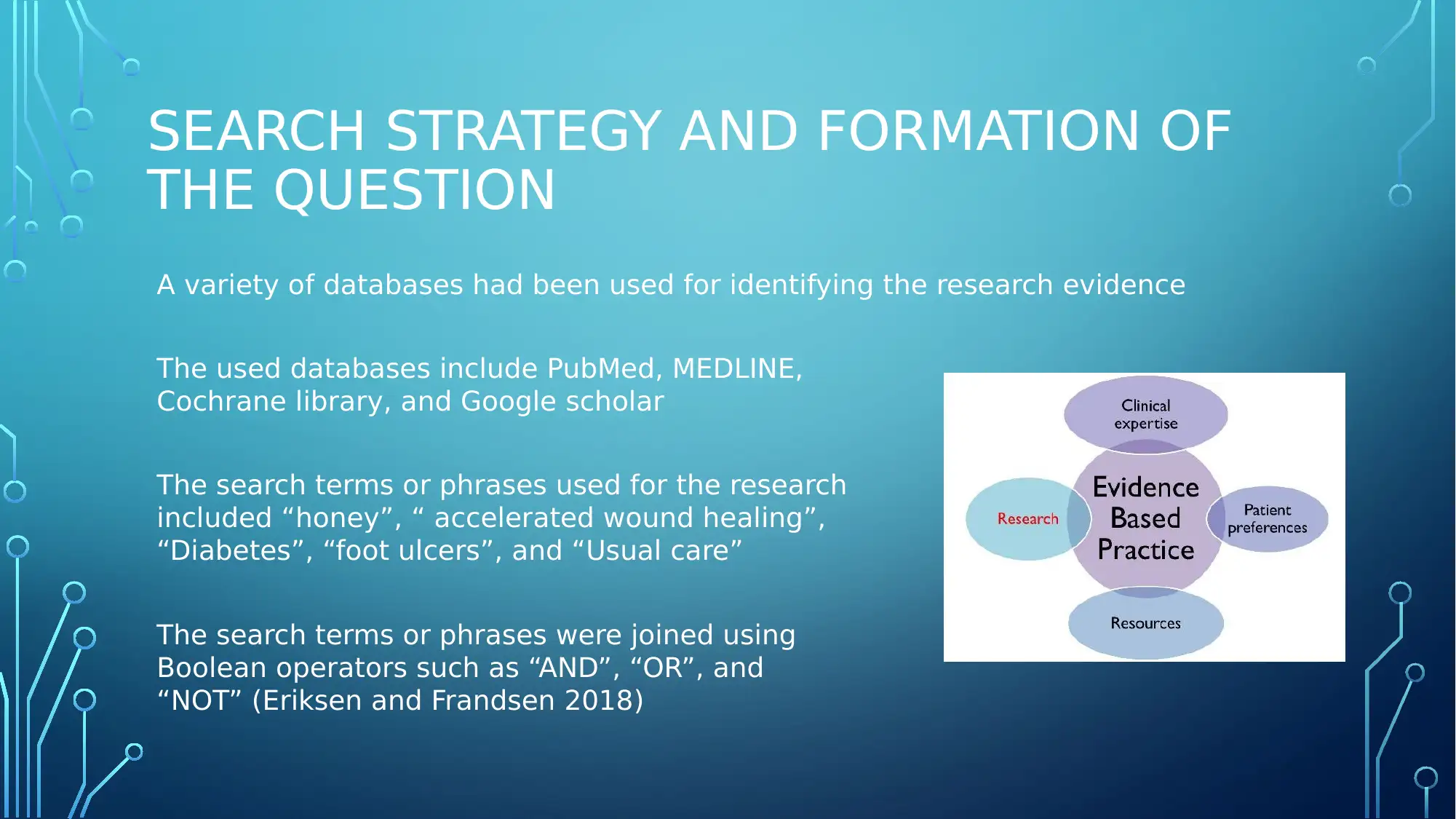
SEARCH STRATEGY AND FORMATION OF
THE QUESTION
A variety of databases had been used for identifying the research evidence
The used databases include PubMed, MEDLINE,
Cochrane library, and Google scholar
The search terms or phrases used for the research
included “honey”, “ accelerated wound healing”,
“Diabetes”, “foot ulcers”, and “Usual care”
The search terms or phrases were joined using
Boolean operators such as “AND”, “OR”, and
“NOT” (Eriksen and Frandsen 2018)
THE QUESTION
A variety of databases had been used for identifying the research evidence
The used databases include PubMed, MEDLINE,
Cochrane library, and Google scholar
The search terms or phrases used for the research
included “honey”, “ accelerated wound healing”,
“Diabetes”, “foot ulcers”, and “Usual care”
The search terms or phrases were joined using
Boolean operators such as “AND”, “OR”, and
“NOT” (Eriksen and Frandsen 2018)

SELECTION CRITERIA
Inclusion criteria:
• Articles published in the last 5 years
• Articles published in English
• Articles using human subjects with diabetes
• Articles that researched on adult consented participants
Exclusion criteria:
• Articles that were published before 2014
• Articles published in any other language other than English
• Articles with research done on animal models
• Articles involving participants that are not adults
Inclusion criteria:
• Articles published in the last 5 years
• Articles published in English
• Articles using human subjects with diabetes
• Articles that researched on adult consented participants
Exclusion criteria:
• Articles that were published before 2014
• Articles published in any other language other than English
• Articles with research done on animal models
• Articles involving participants that are not adults
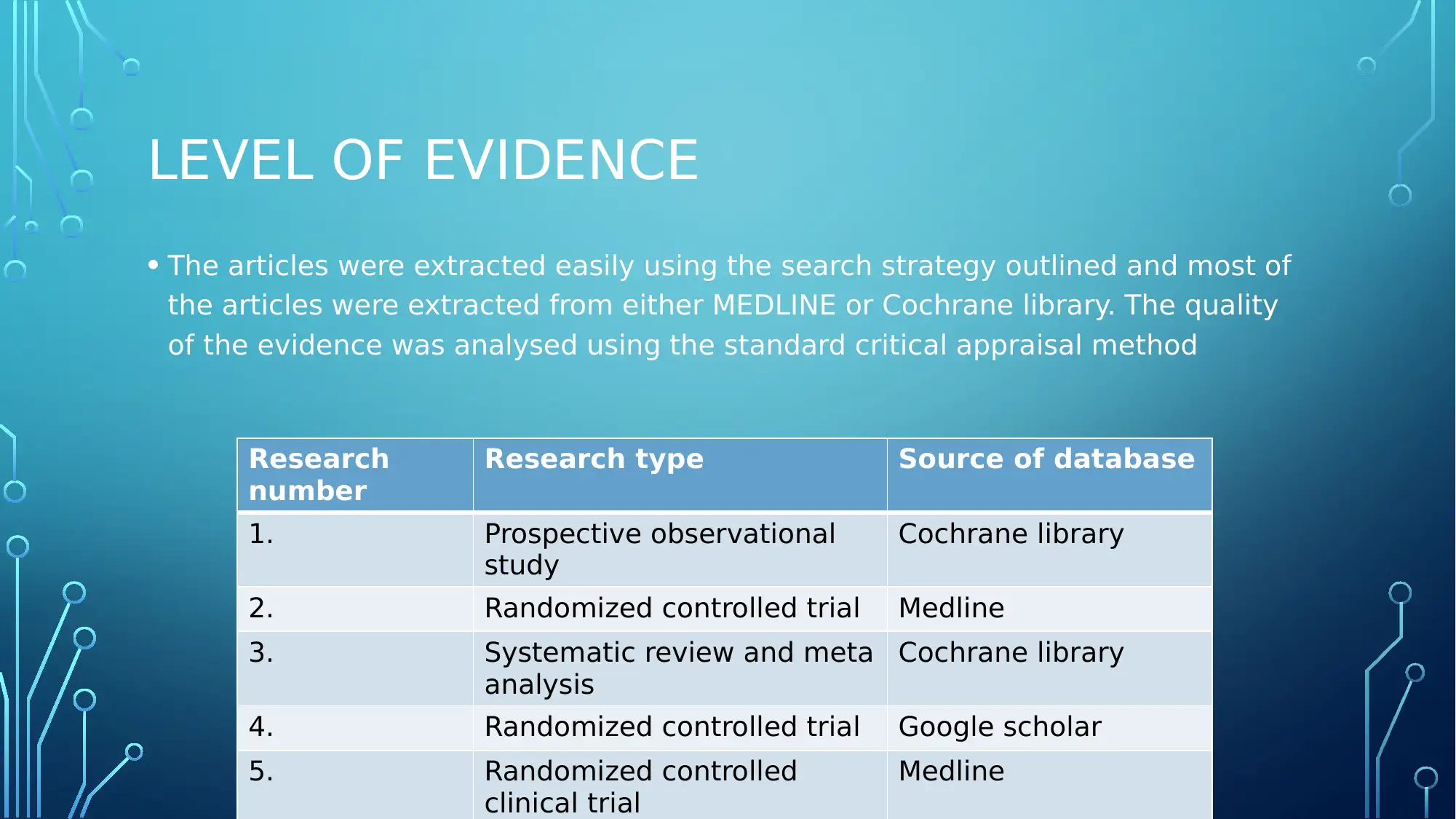
LEVEL OF EVIDENCE
• The articles were extracted easily using the search strategy outlined and most of
the articles were extracted from either MEDLINE or Cochrane library. The quality
of the evidence was analysed using the standard critical appraisal method
Research
number
Research type Source of database
1. Prospective observational
study
Cochrane library
2. Randomized controlled trial Medline
3. Systematic review and meta
analysis
Cochrane library
4. Randomized controlled trial Google scholar
5. Randomized controlled
clinical trial
Medline
• The articles were extracted easily using the search strategy outlined and most of
the articles were extracted from either MEDLINE or Cochrane library. The quality
of the evidence was analysed using the standard critical appraisal method
Research
number
Research type Source of database
1. Prospective observational
study
Cochrane library
2. Randomized controlled trial Medline
3. Systematic review and meta
analysis
Cochrane library
4. Randomized controlled trial Google scholar
5. Randomized controlled
clinical trial
Medline
Paraphrase This Document
Need a fresh take? Get an instant paraphrase of this document with our AI Paraphraser
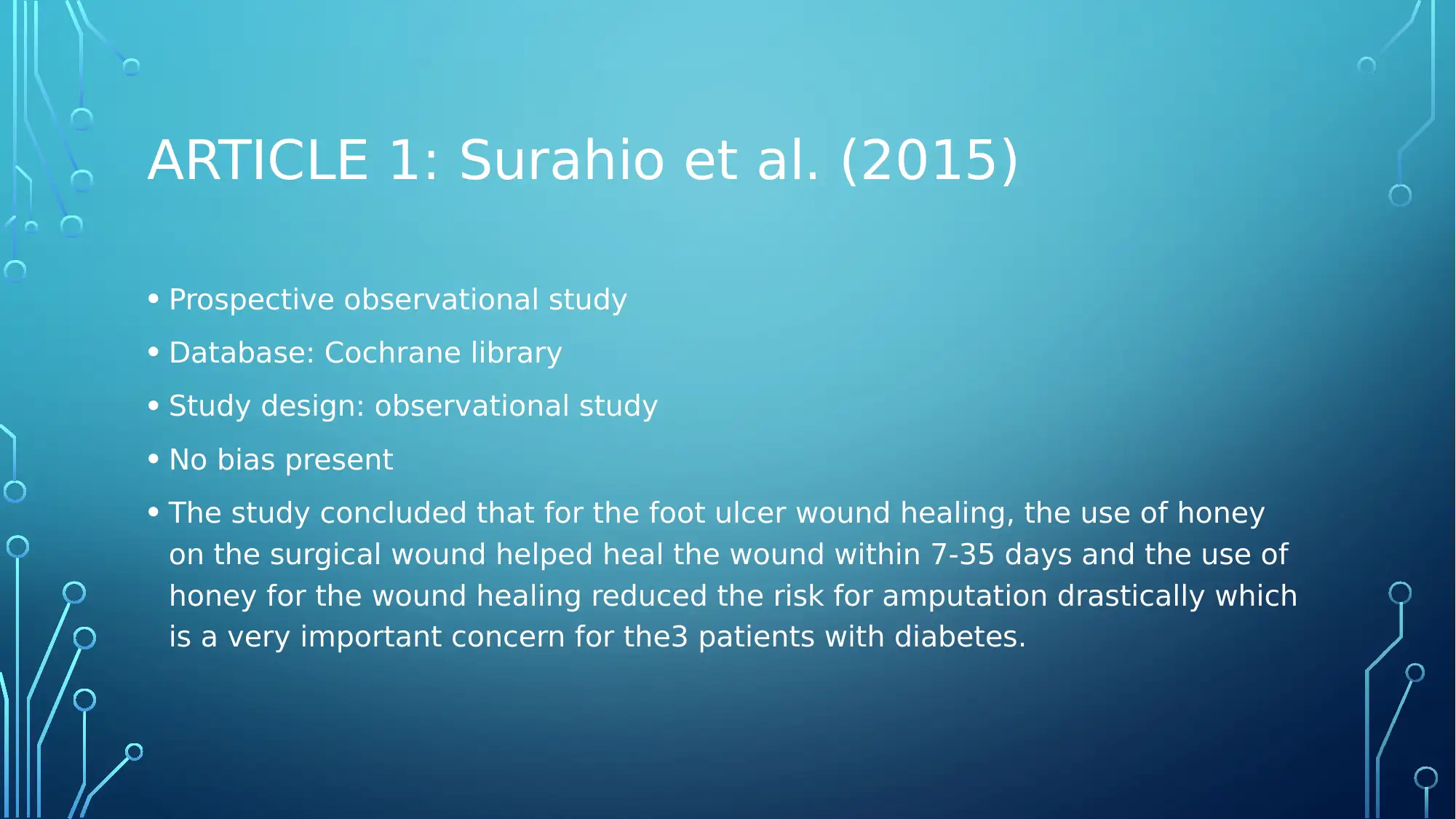
ARTICLE 1: Surahio et al. (2015)
• Prospective observational study
• Database: Cochrane library
• Study design: observational study
• No bias present
• The study concluded that for the foot ulcer wound healing, the use of honey
on the surgical wound helped heal the wound within 7-35 days and the use of
honey for the wound healing reduced the risk for amputation drastically which
is a very important concern for the3 patients with diabetes.
• Prospective observational study
• Database: Cochrane library
• Study design: observational study
• No bias present
• The study concluded that for the foot ulcer wound healing, the use of honey
on the surgical wound helped heal the wound within 7-35 days and the use of
honey for the wound healing reduced the risk for amputation drastically which
is a very important concern for the3 patients with diabetes.
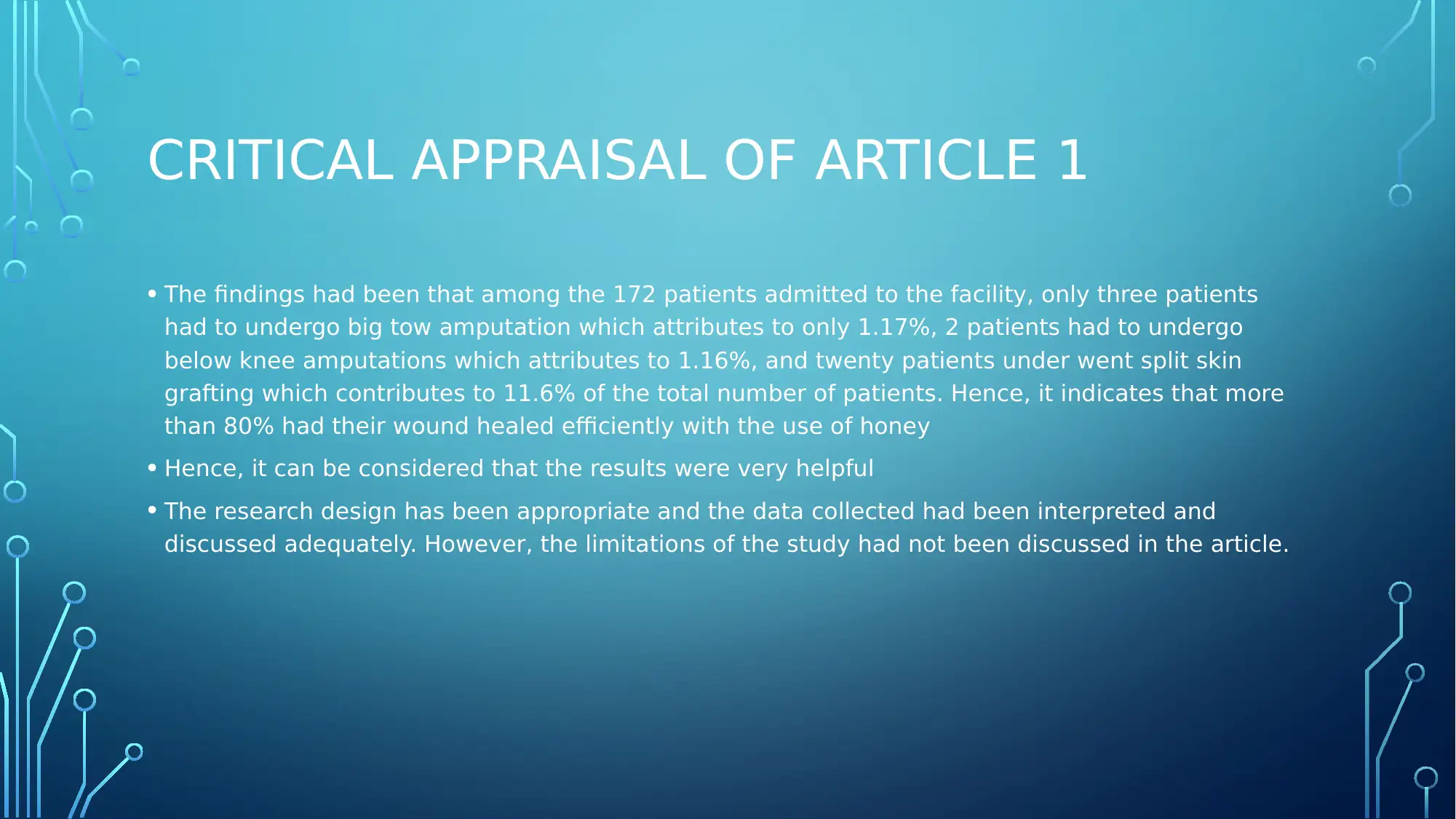
CRITICAL APPRAISAL OF ARTICLE 1
• The findings had been that among the 172 patients admitted to the facility, only three patients
had to undergo big tow amputation which attributes to only 1.17%, 2 patients had to undergo
below knee amputations which attributes to 1.16%, and twenty patients under went split skin
grafting which contributes to 11.6% of the total number of patients. Hence, it indicates that more
than 80% had their wound healed efficiently with the use of honey
• Hence, it can be considered that the results were very helpful
• The research design has been appropriate and the data collected had been interpreted and
discussed adequately. However, the limitations of the study had not been discussed in the article.
• The findings had been that among the 172 patients admitted to the facility, only three patients
had to undergo big tow amputation which attributes to only 1.17%, 2 patients had to undergo
below knee amputations which attributes to 1.16%, and twenty patients under went split skin
grafting which contributes to 11.6% of the total number of patients. Hence, it indicates that more
than 80% had their wound healed efficiently with the use of honey
• Hence, it can be considered that the results were very helpful
• The research design has been appropriate and the data collected had been interpreted and
discussed adequately. However, the limitations of the study had not been discussed in the article.
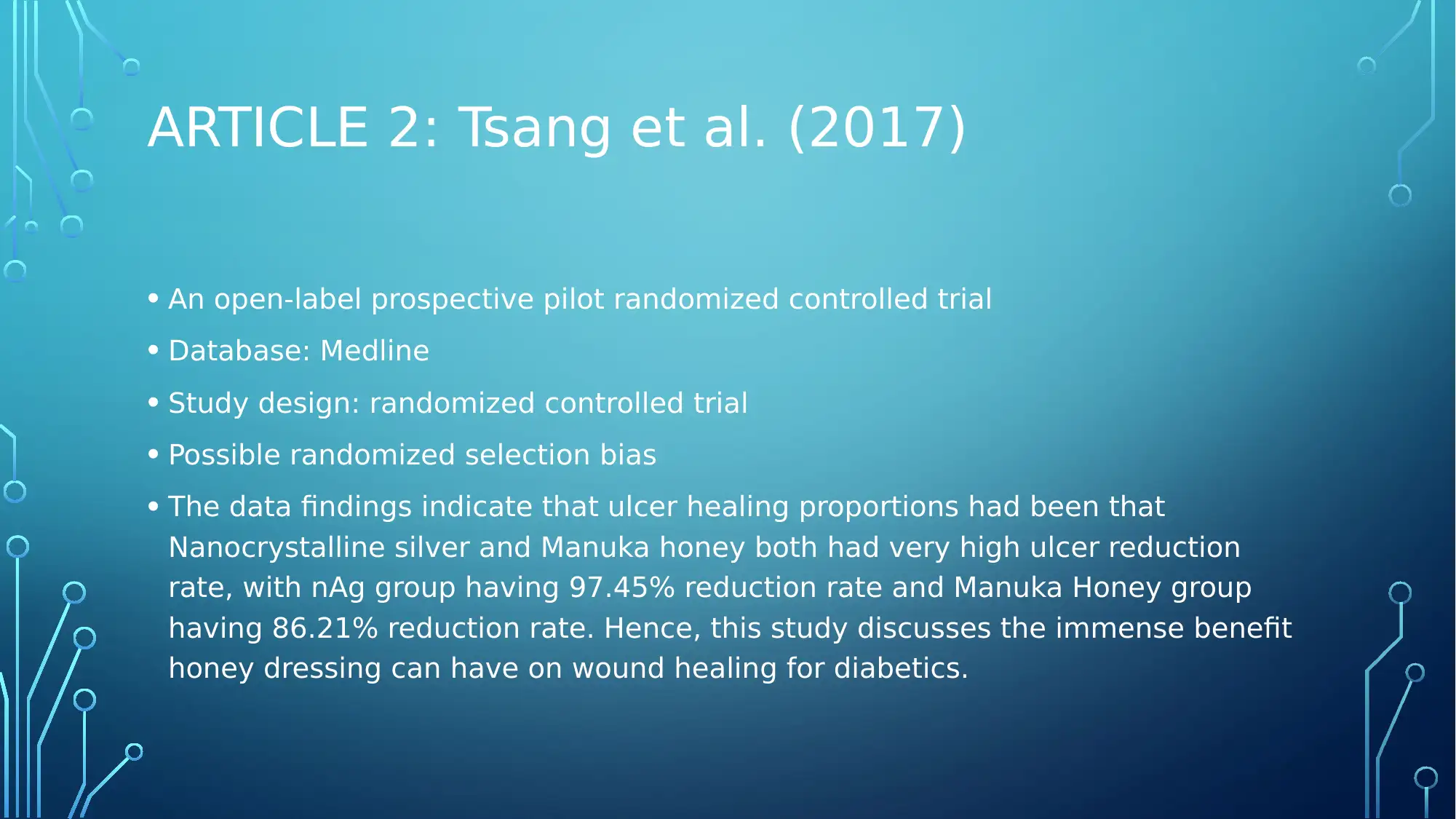
ARTICLE 2: Tsang et al. (2017)
• An open-label prospective pilot randomized controlled trial
• Database: Medline
• Study design: randomized controlled trial
• Possible randomized selection bias
• The data findings indicate that ulcer healing proportions had been that
Nanocrystalline silver and Manuka honey both had very high ulcer reduction
rate, with nAg group having 97.45% reduction rate and Manuka Honey group
having 86.21% reduction rate. Hence, this study discusses the immense benefit
honey dressing can have on wound healing for diabetics.
• An open-label prospective pilot randomized controlled trial
• Database: Medline
• Study design: randomized controlled trial
• Possible randomized selection bias
• The data findings indicate that ulcer healing proportions had been that
Nanocrystalline silver and Manuka honey both had very high ulcer reduction
rate, with nAg group having 97.45% reduction rate and Manuka Honey group
having 86.21% reduction rate. Hence, this study discusses the immense benefit
honey dressing can have on wound healing for diabetics.
Secure Best Marks with AI Grader
Need help grading? Try our AI Grader for instant feedback on your assignments.
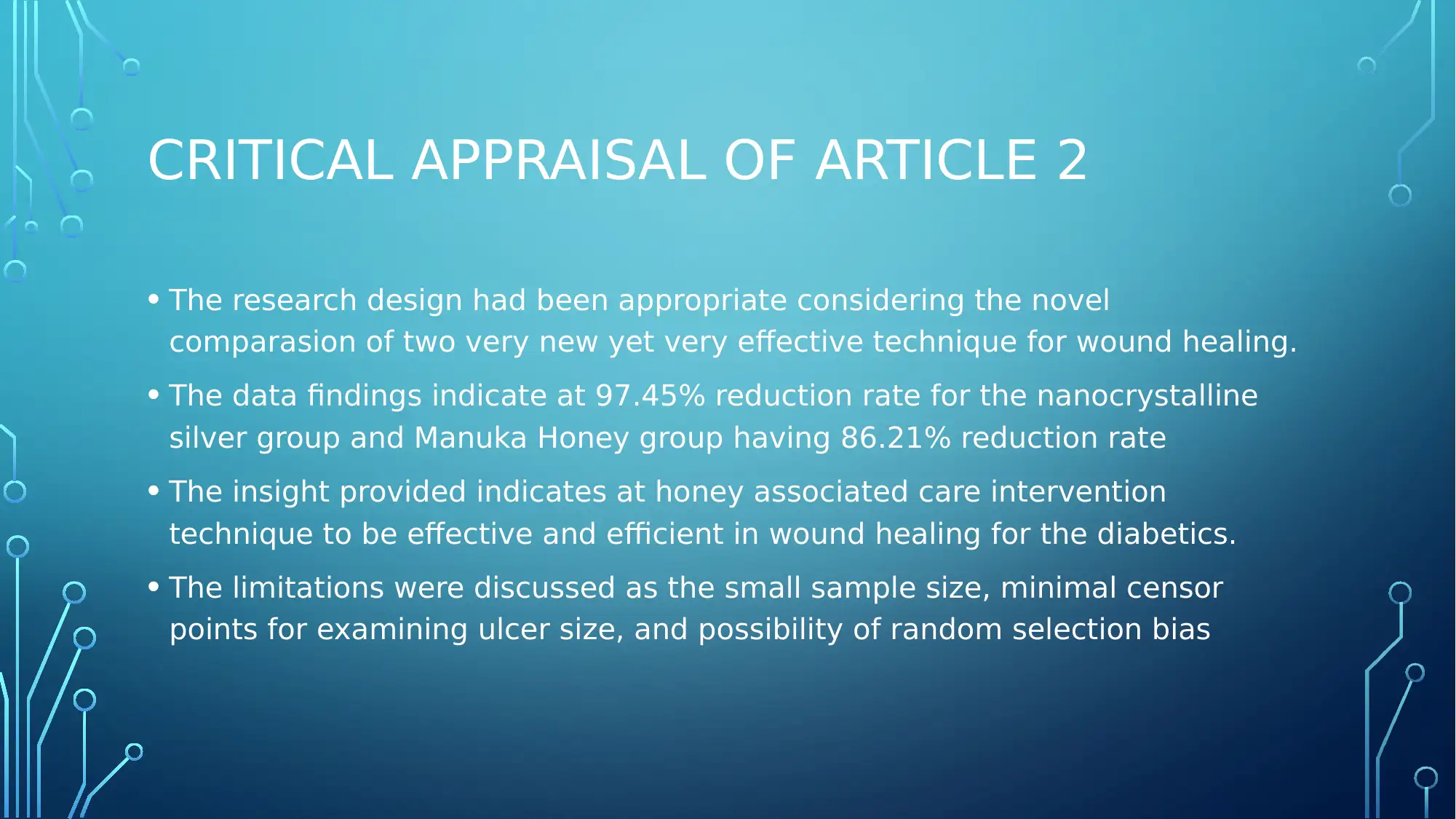
CRITICAL APPRAISAL OF ARTICLE 2
• The research design had been appropriate considering the novel
comparasion of two very new yet very effective technique for wound healing.
• The data findings indicate at 97.45% reduction rate for the nanocrystalline
silver group and Manuka Honey group having 86.21% reduction rate
• The insight provided indicates at honey associated care intervention
technique to be effective and efficient in wound healing for the diabetics.
• The limitations were discussed as the small sample size, minimal censor
points for examining ulcer size, and possibility of random selection bias
• The research design had been appropriate considering the novel
comparasion of two very new yet very effective technique for wound healing.
• The data findings indicate at 97.45% reduction rate for the nanocrystalline
silver group and Manuka Honey group having 86.21% reduction rate
• The insight provided indicates at honey associated care intervention
technique to be effective and efficient in wound healing for the diabetics.
• The limitations were discussed as the small sample size, minimal censor
points for examining ulcer size, and possibility of random selection bias

ARTICLE 3: Wang et al. (2018)
• Systematic review with Meta-analysis
• Database: Cochrane Library
• Study design: systematic review
• No bias reported
• The data findings indicated the fact that the use of honey in the wound
healing process for the diabetic patients helped reducing the wound
debridement time, wound healing time, and bacterial clearance time
• Systematic review with Meta-analysis
• Database: Cochrane Library
• Study design: systematic review
• No bias reported
• The data findings indicated the fact that the use of honey in the wound
healing process for the diabetic patients helped reducing the wound
debridement time, wound healing time, and bacterial clearance time
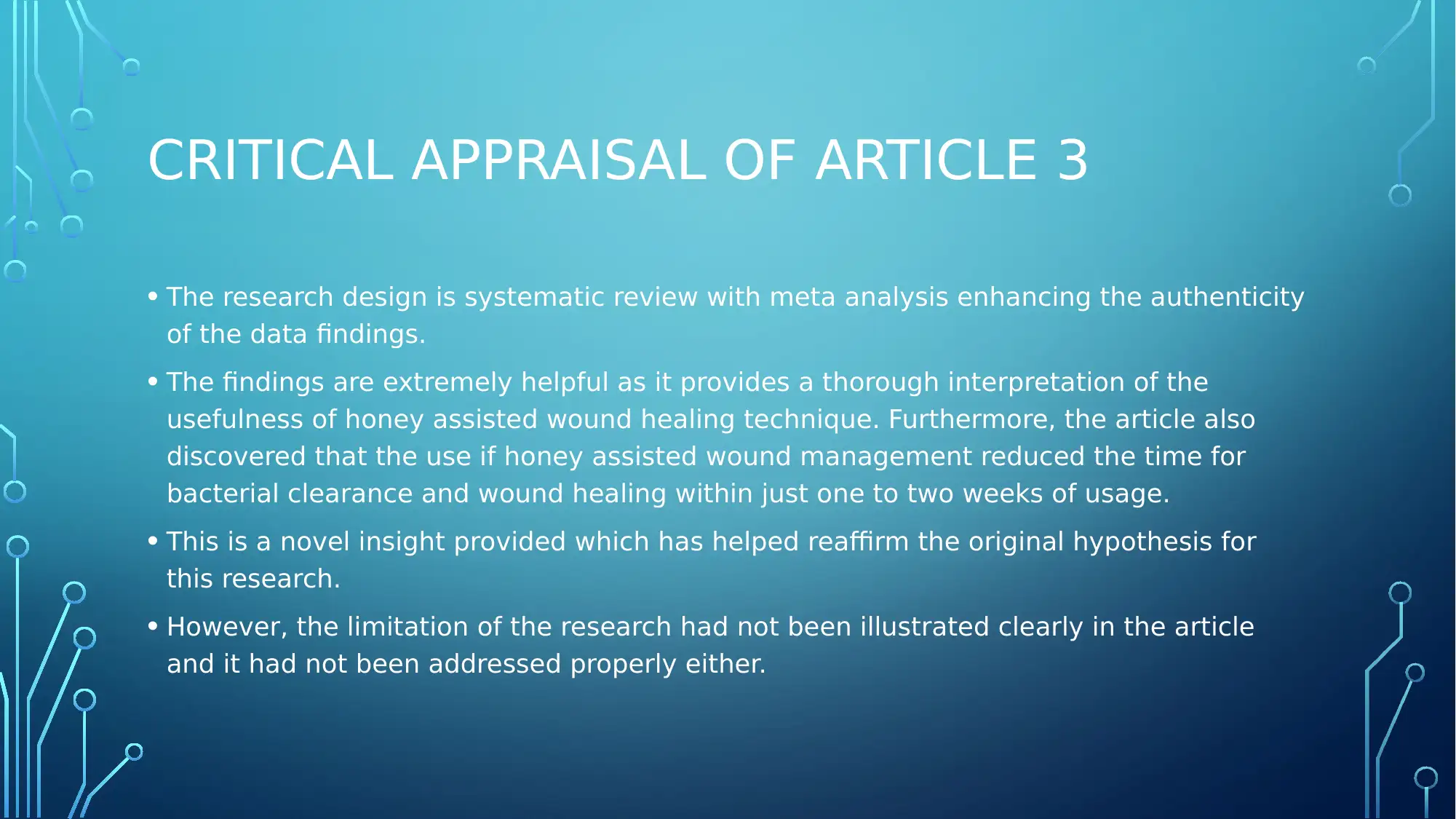
CRITICAL APPRAISAL OF ARTICLE 3
• The research design is systematic review with meta analysis enhancing the authenticity
of the data findings.
• The findings are extremely helpful as it provides a thorough interpretation of the
usefulness of honey assisted wound healing technique. Furthermore, the article also
discovered that the use if honey assisted wound management reduced the time for
bacterial clearance and wound healing within just one to two weeks of usage.
• This is a novel insight provided which has helped reaffirm the original hypothesis for
this research.
• However, the limitation of the research had not been illustrated clearly in the article
and it had not been addressed properly either.
• The research design is systematic review with meta analysis enhancing the authenticity
of the data findings.
• The findings are extremely helpful as it provides a thorough interpretation of the
usefulness of honey assisted wound healing technique. Furthermore, the article also
discovered that the use if honey assisted wound management reduced the time for
bacterial clearance and wound healing within just one to two weeks of usage.
• This is a novel insight provided which has helped reaffirm the original hypothesis for
this research.
• However, the limitation of the research had not been illustrated clearly in the article
and it had not been addressed properly either.
Paraphrase This Document
Need a fresh take? Get an instant paraphrase of this document with our AI Paraphraser

ARTICLE 4: Kamaratos et al. (2014)
• Prospective randomised, controlled, double‐blinded study
• Database: Google scholar
• Study design: Randomized controlled trial
• Bias not reported
• In this study, the data findings differed and indicated a 7% difference in
the efficiency of wound healing of the neuropathic foot ulcer. Yet the
Manuka-honey impregnated silica dressing had 97% success rate in
healing the wounds.
• Prospective randomised, controlled, double‐blinded study
• Database: Google scholar
• Study design: Randomized controlled trial
• Bias not reported
• In this study, the data findings differed and indicated a 7% difference in
the efficiency of wound healing of the neuropathic foot ulcer. Yet the
Manuka-honey impregnated silica dressing had 97% success rate in
healing the wounds.

CRITICAL APPRAISAL OF ARTICLE 4
• The research design was randomized controlled double blinded study where
both participants and the researchers did not know what intervention was
being given to them. Hence, the research design was effective.
• The data findings indicates the group I patients 78·13% of ulcers became
sterile during the first week versus 35·5% in group II patients. Hence, the
MHID represents a very useful intervention technique for the diabetics with
foot ulcer or any other type of wound.
• The limitation of the research had not been illustrated clearly in the article
and it had not been addressed properly either.
• The research design was randomized controlled double blinded study where
both participants and the researchers did not know what intervention was
being given to them. Hence, the research design was effective.
• The data findings indicates the group I patients 78·13% of ulcers became
sterile during the first week versus 35·5% in group II patients. Hence, the
MHID represents a very useful intervention technique for the diabetics with
foot ulcer or any other type of wound.
• The limitation of the research had not been illustrated clearly in the article
and it had not been addressed properly either.
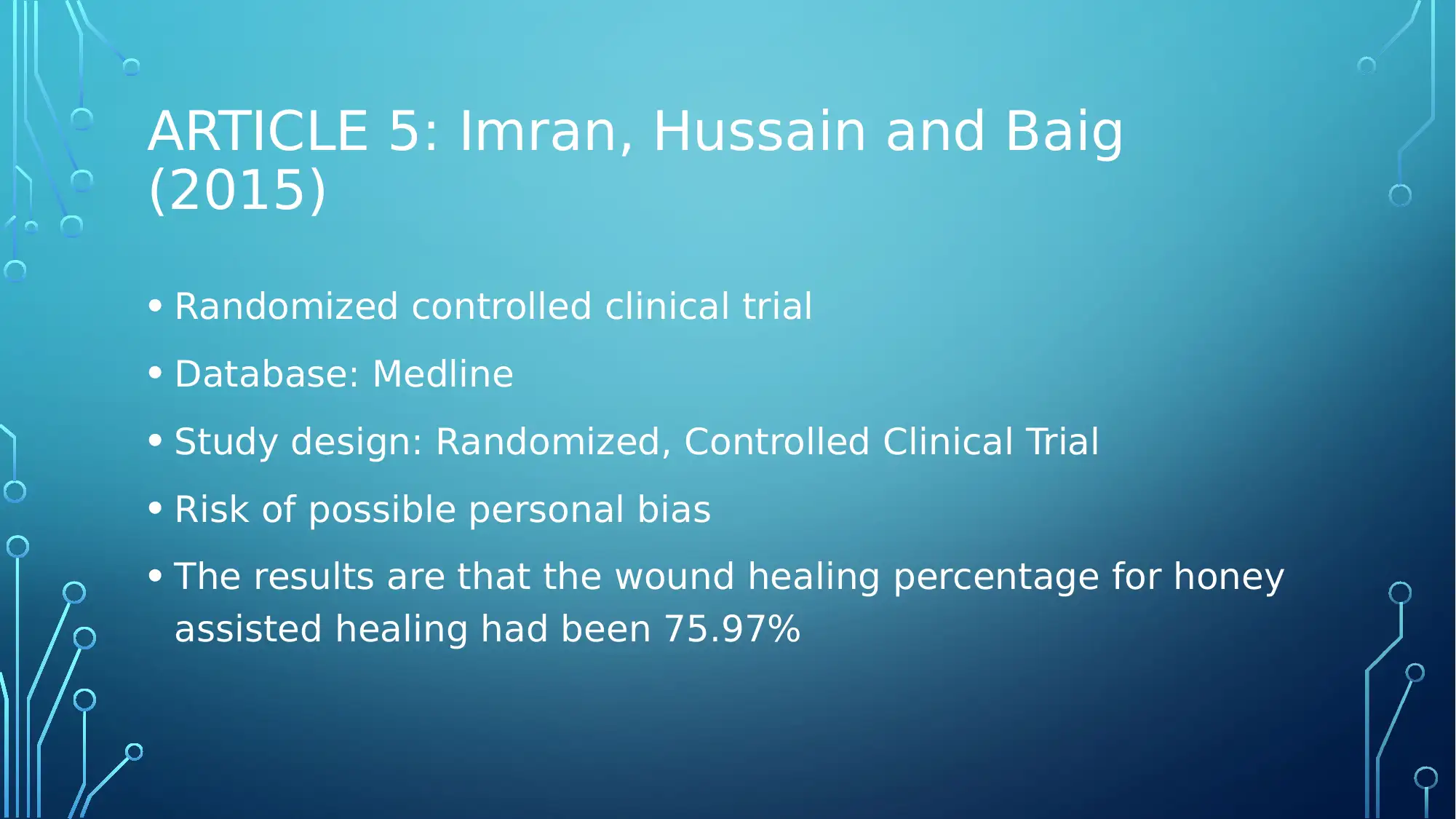
ARTICLE 5: Imran, Hussain and Baig
(2015)
• Randomized controlled clinical trial
• Database: Medline
• Study design: Randomized, Controlled Clinical Trial
• Risk of possible personal bias
• The results are that the wound healing percentage for honey
assisted healing had been 75.97%
(2015)
• Randomized controlled clinical trial
• Database: Medline
• Study design: Randomized, Controlled Clinical Trial
• Risk of possible personal bias
• The results are that the wound healing percentage for honey
assisted healing had been 75.97%
Secure Best Marks with AI Grader
Need help grading? Try our AI Grader for instant feedback on your assignments.
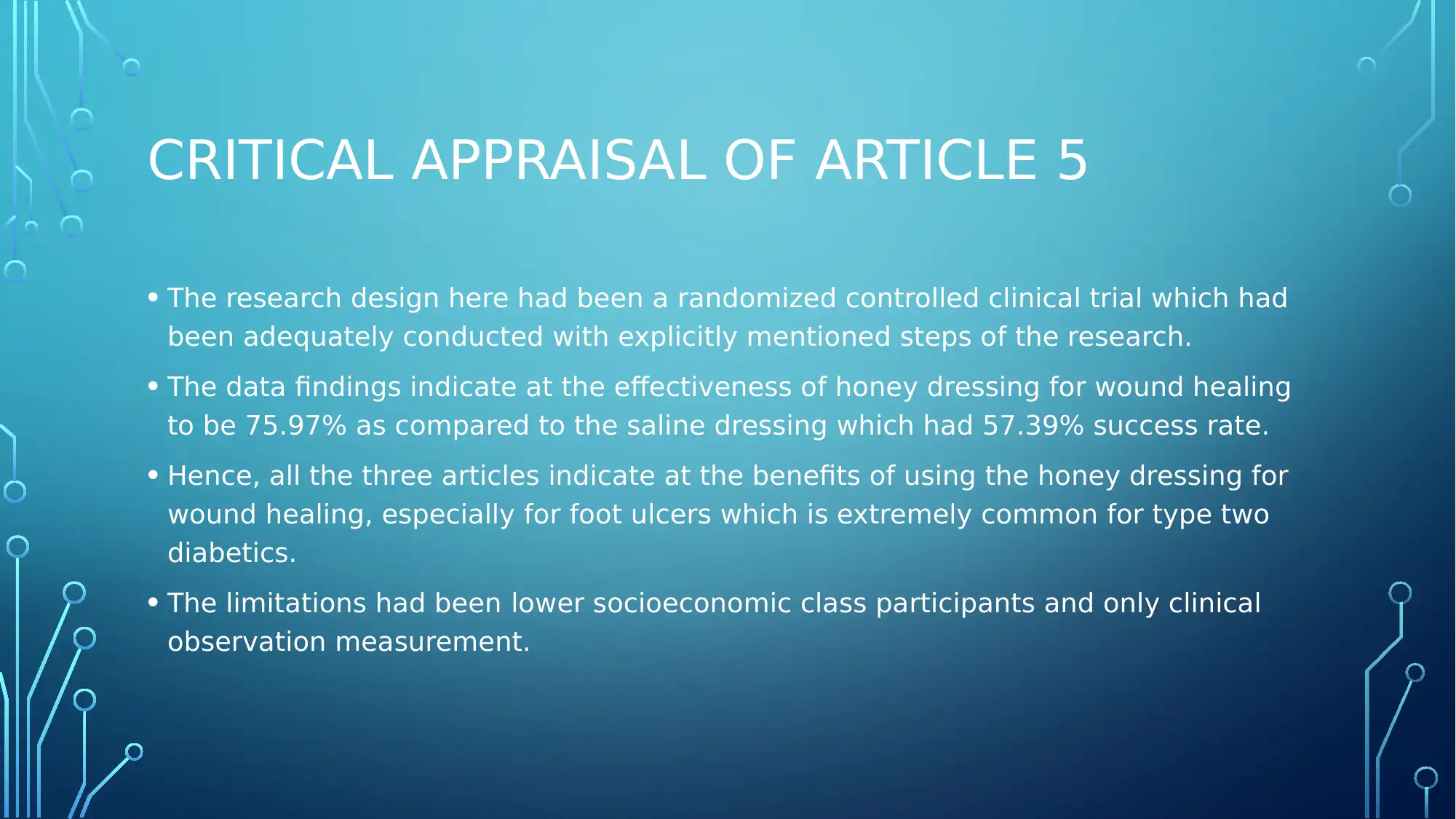
CRITICAL APPRAISAL OF ARTICLE 5
• The research design here had been a randomized controlled clinical trial which had
been adequately conducted with explicitly mentioned steps of the research.
• The data findings indicate at the effectiveness of honey dressing for wound healing
to be 75.97% as compared to the saline dressing which had 57.39% success rate.
• Hence, all the three articles indicate at the benefits of using the honey dressing for
wound healing, especially for foot ulcers which is extremely common for type two
diabetics.
• The limitations had been lower socioeconomic class participants and only clinical
observation measurement.
• The research design here had been a randomized controlled clinical trial which had
been adequately conducted with explicitly mentioned steps of the research.
• The data findings indicate at the effectiveness of honey dressing for wound healing
to be 75.97% as compared to the saline dressing which had 57.39% success rate.
• Hence, all the three articles indicate at the benefits of using the honey dressing for
wound healing, especially for foot ulcers which is extremely common for type two
diabetics.
• The limitations had been lower socioeconomic class participants and only clinical
observation measurement.
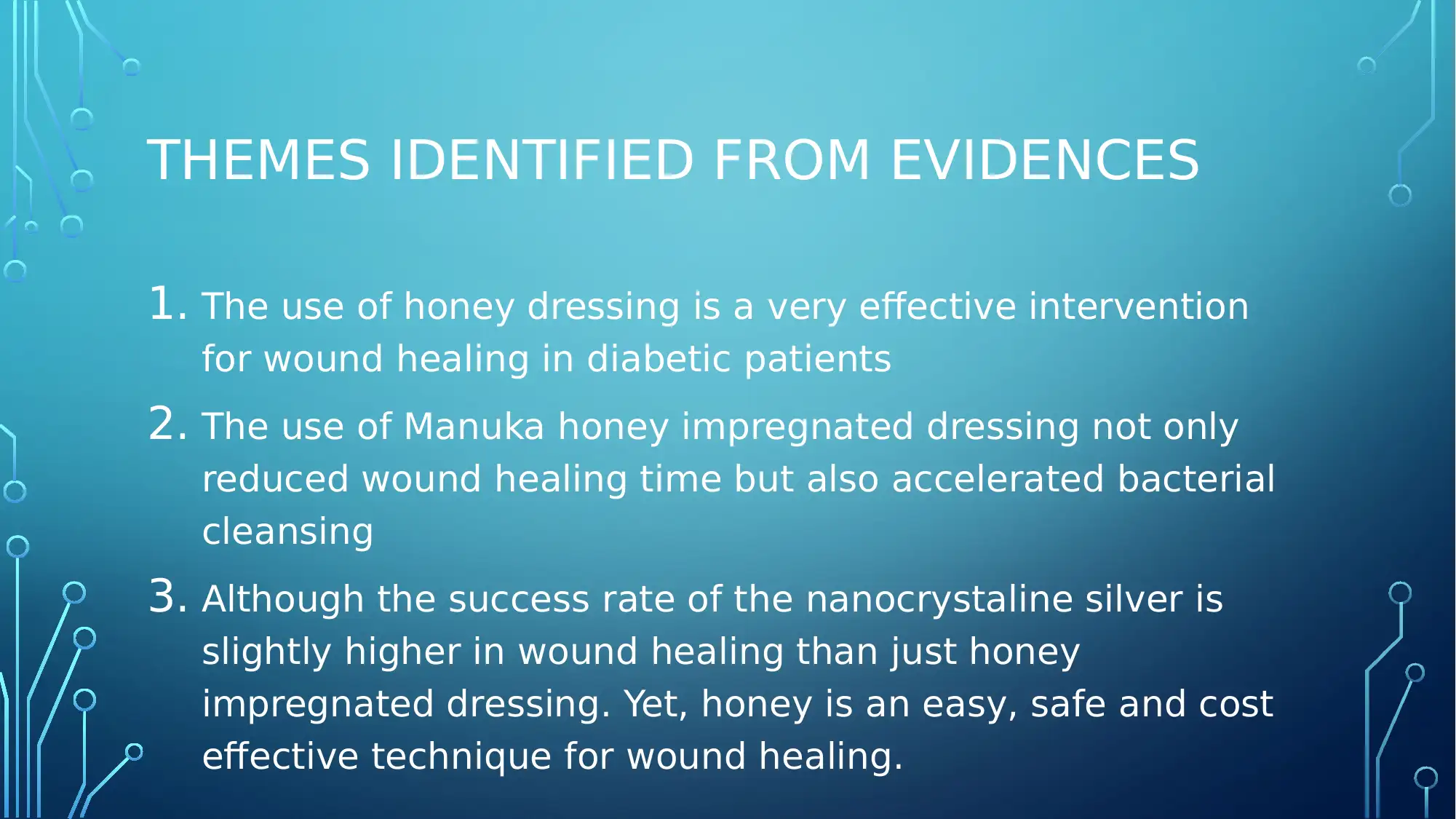
THEMES IDENTIFIED FROM EVIDENCES
1. The use of honey dressing is a very effective intervention
for wound healing in diabetic patients
2. The use of Manuka honey impregnated dressing not only
reduced wound healing time but also accelerated bacterial
cleansing
3. Although the success rate of the nanocrystaline silver is
slightly higher in wound healing than just honey
impregnated dressing. Yet, honey is an easy, safe and cost
effective technique for wound healing.
1. The use of honey dressing is a very effective intervention
for wound healing in diabetic patients
2. The use of Manuka honey impregnated dressing not only
reduced wound healing time but also accelerated bacterial
cleansing
3. Although the success rate of the nanocrystaline silver is
slightly higher in wound healing than just honey
impregnated dressing. Yet, honey is an easy, safe and cost
effective technique for wound healing.
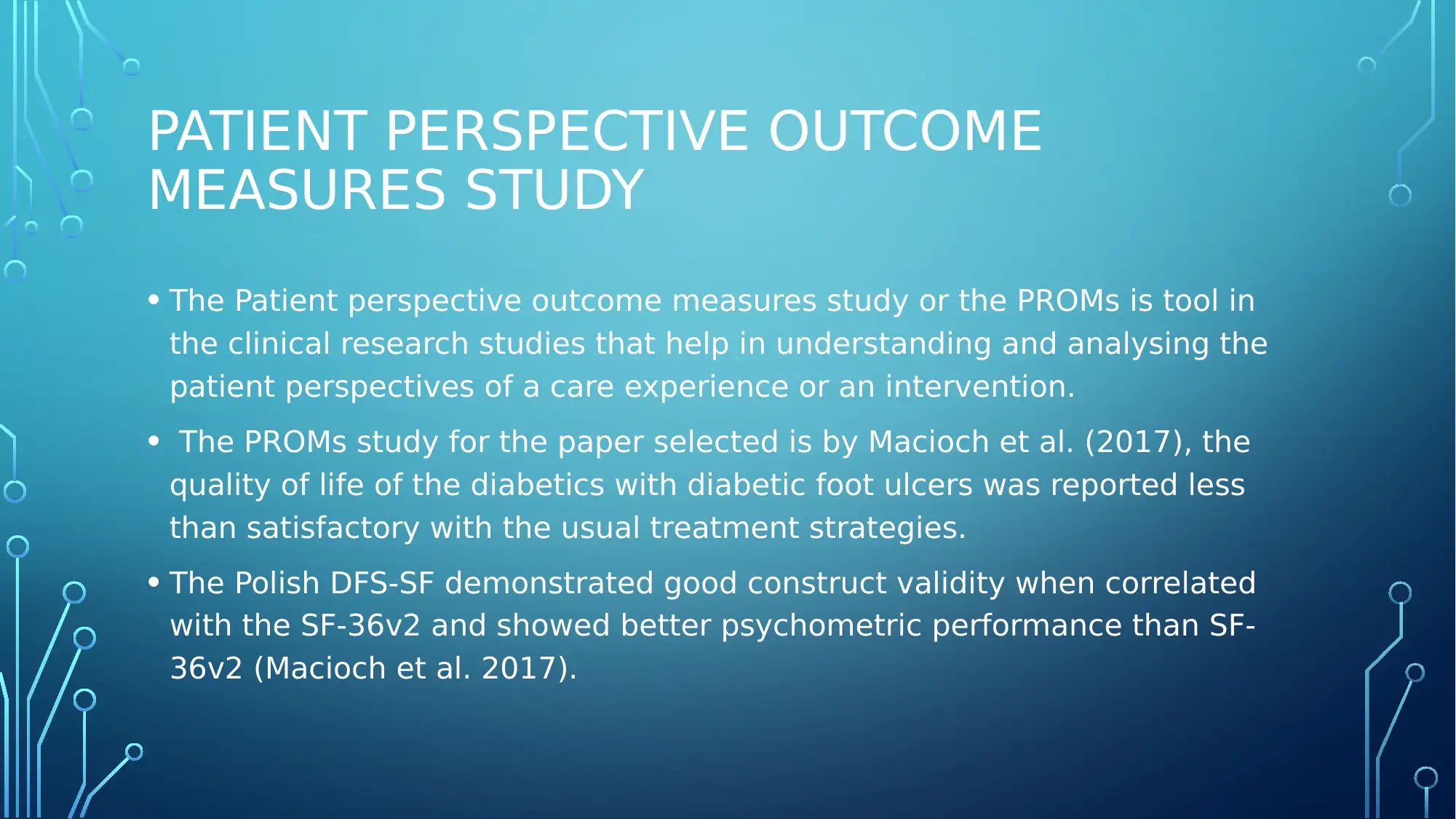
PATIENT PERSPECTIVE OUTCOME
MEASURES STUDY
• The Patient perspective outcome measures study or the PROMs is tool in
the clinical research studies that help in understanding and analysing the
patient perspectives of a care experience or an intervention.
• The PROMs study for the paper selected is by Macioch et al. (2017), the
quality of life of the diabetics with diabetic foot ulcers was reported less
than satisfactory with the usual treatment strategies.
• The Polish DFS-SF demonstrated good construct validity when correlated
with the SF-36v2 and showed better psychometric performance than SF-
36v2 (Macioch et al. 2017).
MEASURES STUDY
• The Patient perspective outcome measures study or the PROMs is tool in
the clinical research studies that help in understanding and analysing the
patient perspectives of a care experience or an intervention.
• The PROMs study for the paper selected is by Macioch et al. (2017), the
quality of life of the diabetics with diabetic foot ulcers was reported less
than satisfactory with the usual treatment strategies.
• The Polish DFS-SF demonstrated good construct validity when correlated
with the SF-36v2 and showed better psychometric performance than SF-
36v2 (Macioch et al. 2017).
Paraphrase This Document
Need a fresh take? Get an instant paraphrase of this document with our AI Paraphraser
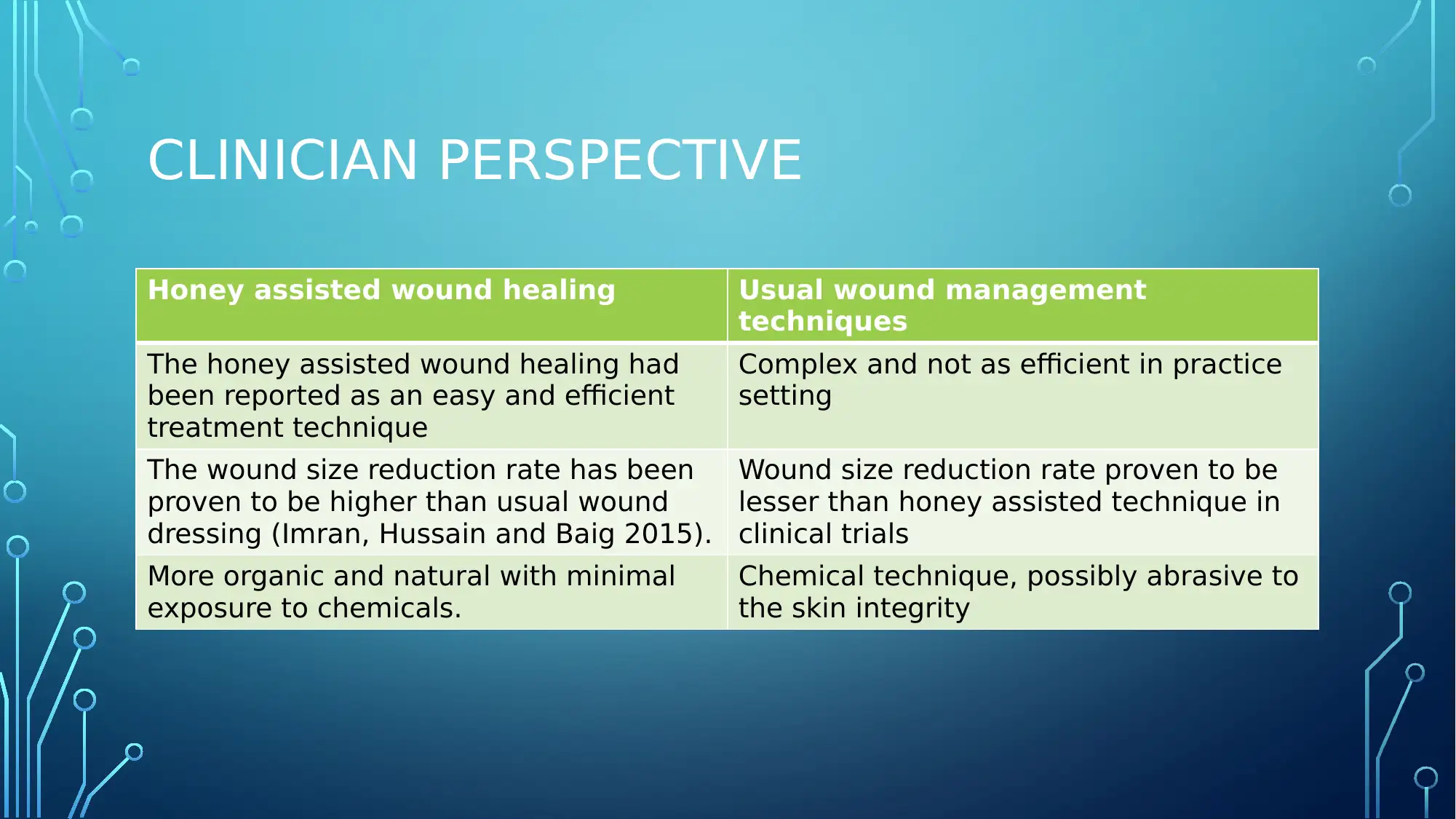
CLINICIAN PERSPECTIVE
Honey assisted wound healing Usual wound management
techniques
The honey assisted wound healing had
been reported as an easy and efficient
treatment technique
Complex and not as efficient in practice
setting
The wound size reduction rate has been
proven to be higher than usual wound
dressing (Imran, Hussain and Baig 2015).
Wound size reduction rate proven to be
lesser than honey assisted technique in
clinical trials
More organic and natural with minimal
exposure to chemicals.
Chemical technique, possibly abrasive to
the skin integrity
Honey assisted wound healing Usual wound management
techniques
The honey assisted wound healing had
been reported as an easy and efficient
treatment technique
Complex and not as efficient in practice
setting
The wound size reduction rate has been
proven to be higher than usual wound
dressing (Imran, Hussain and Baig 2015).
Wound size reduction rate proven to be
lesser than honey assisted technique in
clinical trials
More organic and natural with minimal
exposure to chemicals.
Chemical technique, possibly abrasive to
the skin integrity

PRACTICE IMPLICATION
RECOMMENDATIONS
• The honey impregnated dressing can be easily implemented
in the clinical practice setting by training the existing staff.
• There is need for better infrastructure and resources to
implement the honey impregnated dressings in the wound
healing
• There is need for public awareness to enhance the patient
literacy regarding the use of this novel technique so that the
patients can themselves advocate for the intervention.
RECOMMENDATIONS
• The honey impregnated dressing can be easily implemented
in the clinical practice setting by training the existing staff.
• There is need for better infrastructure and resources to
implement the honey impregnated dressings in the wound
healing
• There is need for public awareness to enhance the patient
literacy regarding the use of this novel technique so that the
patients can themselves advocate for the intervention.
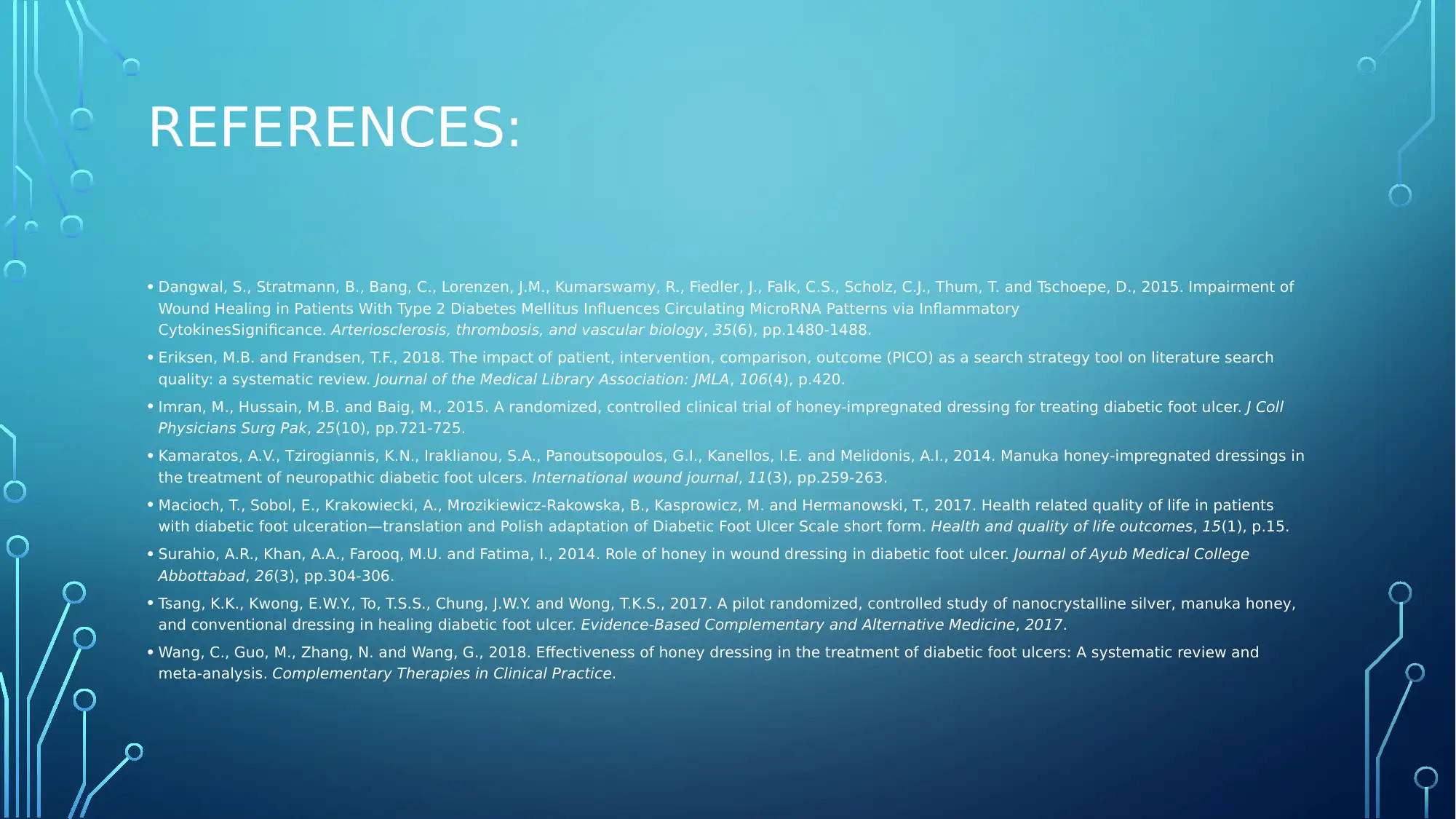
REFERENCES:
• Dangwal, S., Stratmann, B., Bang, C., Lorenzen, J.M., Kumarswamy, R., Fiedler, J., Falk, C.S., Scholz, C.J., Thum, T. and Tschoepe, D., 2015. Impairment of
Wound Healing in Patients With Type 2 Diabetes Mellitus Influences Circulating MicroRNA Patterns via Inflammatory
CytokinesSignificance. Arteriosclerosis, thrombosis, and vascular biology, 35(6), pp.1480-1488.
• Eriksen, M.B. and Frandsen, T.F., 2018. The impact of patient, intervention, comparison, outcome (PICO) as a search strategy tool on literature search
quality: a systematic review. Journal of the Medical Library Association: JMLA, 106(4), p.420.
• Imran, M., Hussain, M.B. and Baig, M., 2015. A randomized, controlled clinical trial of honey-impregnated dressing for treating diabetic foot ulcer. J Coll
Physicians Surg Pak, 25(10), pp.721-725.
• Kamaratos, A.V., Tzirogiannis, K.N., Iraklianou, S.A., Panoutsopoulos, G.I., Kanellos, I.E. and Melidonis, A.I., 2014. Manuka honey‐impregnated dressings in
the treatment of neuropathic diabetic foot ulcers. International wound journal, 11(3), pp.259-263.
• Macioch, T., Sobol, E., Krakowiecki, A., Mrozikiewicz-Rakowska, B., Kasprowicz, M. and Hermanowski, T., 2017. Health related quality of life in patients
with diabetic foot ulceration—translation and Polish adaptation of Diabetic Foot Ulcer Scale short form. Health and quality of life outcomes, 15(1), p.15.
• Surahio, A.R., Khan, A.A., Farooq, M.U. and Fatima, I., 2014. Role of honey in wound dressing in diabetic foot ulcer. Journal of Ayub Medical College
Abbottabad, 26(3), pp.304-306.
• Tsang, K.K., Kwong, E.W.Y., To, T.S.S., Chung, J.W.Y. and Wong, T.K.S., 2017. A pilot randomized, controlled study of nanocrystalline silver, manuka honey,
and conventional dressing in healing diabetic foot ulcer. Evidence-Based Complementary and Alternative Medicine, 2017.
• Wang, C., Guo, M., Zhang, N. and Wang, G., 2018. Effectiveness of honey dressing in the treatment of diabetic foot ulcers: A systematic review and
meta-analysis. Complementary Therapies in Clinical Practice.
• Dangwal, S., Stratmann, B., Bang, C., Lorenzen, J.M., Kumarswamy, R., Fiedler, J., Falk, C.S., Scholz, C.J., Thum, T. and Tschoepe, D., 2015. Impairment of
Wound Healing in Patients With Type 2 Diabetes Mellitus Influences Circulating MicroRNA Patterns via Inflammatory
CytokinesSignificance. Arteriosclerosis, thrombosis, and vascular biology, 35(6), pp.1480-1488.
• Eriksen, M.B. and Frandsen, T.F., 2018. The impact of patient, intervention, comparison, outcome (PICO) as a search strategy tool on literature search
quality: a systematic review. Journal of the Medical Library Association: JMLA, 106(4), p.420.
• Imran, M., Hussain, M.B. and Baig, M., 2015. A randomized, controlled clinical trial of honey-impregnated dressing for treating diabetic foot ulcer. J Coll
Physicians Surg Pak, 25(10), pp.721-725.
• Kamaratos, A.V., Tzirogiannis, K.N., Iraklianou, S.A., Panoutsopoulos, G.I., Kanellos, I.E. and Melidonis, A.I., 2014. Manuka honey‐impregnated dressings in
the treatment of neuropathic diabetic foot ulcers. International wound journal, 11(3), pp.259-263.
• Macioch, T., Sobol, E., Krakowiecki, A., Mrozikiewicz-Rakowska, B., Kasprowicz, M. and Hermanowski, T., 2017. Health related quality of life in patients
with diabetic foot ulceration—translation and Polish adaptation of Diabetic Foot Ulcer Scale short form. Health and quality of life outcomes, 15(1), p.15.
• Surahio, A.R., Khan, A.A., Farooq, M.U. and Fatima, I., 2014. Role of honey in wound dressing in diabetic foot ulcer. Journal of Ayub Medical College
Abbottabad, 26(3), pp.304-306.
• Tsang, K.K., Kwong, E.W.Y., To, T.S.S., Chung, J.W.Y. and Wong, T.K.S., 2017. A pilot randomized, controlled study of nanocrystalline silver, manuka honey,
and conventional dressing in healing diabetic foot ulcer. Evidence-Based Complementary and Alternative Medicine, 2017.
• Wang, C., Guo, M., Zhang, N. and Wang, G., 2018. Effectiveness of honey dressing in the treatment of diabetic foot ulcers: A systematic review and
meta-analysis. Complementary Therapies in Clinical Practice.
Secure Best Marks with AI Grader
Need help grading? Try our AI Grader for instant feedback on your assignments.

THANK YOU!
1 out of 23
Related Documents
Your All-in-One AI-Powered Toolkit for Academic Success.
+13062052269
info@desklib.com
Available 24*7 on WhatsApp / Email
![[object Object]](/_next/static/media/star-bottom.7253800d.svg)
Unlock your academic potential
© 2024 | Zucol Services PVT LTD | All rights reserved.




